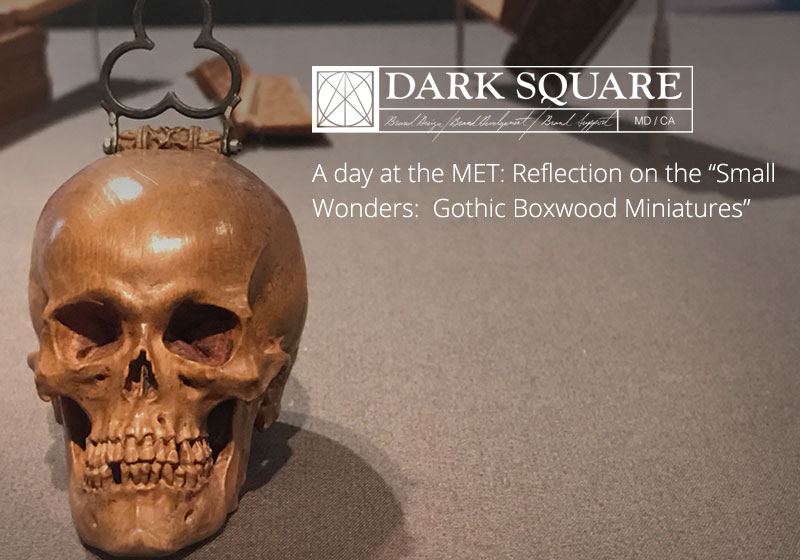Dark Square takes a look at the UX in one of the world’s most fascinating16th-century masterpieces while exploring the importance of UX and interactive design in future technology
Recently while in New York, the Dark Square team decided to travel to Upper Manhattan and view the new exhibits on display at the Metropolitan Museum of Art. While touring the MET, we found a particular interest in the extensive collection located at the MET Cloisters.
Overlooking the Hudson River, The Cloisters is dedicated to the art, architecture, and garden style of medieval Europe. Visitors can feel as though they are stepping back in time through the structure of the building itself, which is named after the medieval French sourced cloisters that form the core of the building. Inside the Museum is approximately 2,000 works of art from the medieval west, largely dating to the 12th through the 15th century; including small-scale works, crosses, manuscript illumination from bibles, biblical sculptures and altarpieces, tapestries, and stained-glass artworks.

One exhibit we were particularly struck by at The MET Cloisters was the special exhibit “Small Wonders: Gothic Boxwood Miniatures”. The exhibit, which is on display through May 21, 2017, features a collection of intricately carved diminutive altarpieces, coffins, and miniature prayer beads -some measuring two inches in diameter- representing sainthood, the balance of life and death, and principal moments throughout the Christian Bible. The detailed three-dimensional carvings and inscriptions on such a miniature service were carved with creative and religious determination that left us in admiration.
Created in the Netherlands during the early 16th century, these micro-carving altarpieces and rosaries beads were created from a single piece of boxwood dissected into fragments and then reassembled together. For over 500 years, viewers from around the world were both fascinated and puzzled by the process used to transform a single boxwood fragment into a single panorama with intricate miniature carvings, layers, and text.
The process used by the carvers remained a mystery until a recent collaboration between the Art Gallery of Ontario, the Rijksmuseum, and The Metropolitan Museum of Art, where it was unveiled through X-rays, micro-CT scanning, and advanced 3D Analysis Software that tiny wooden pegs secured multiple panels overlaid to create each rosary bead. Each panel was carved individually from above, front, and back and then pieced together to create the three-dimensional scene. When formed together through the pegs, the final product served as a theatrical yet intimate look into the story of the Bible.
What is so remarkable about the artist’s work, is his ability to create an intimate, entertaining, and educational experience with the subject, unheard of throughout the 15th and 16th century. With the Roman Catholic Church as the head authority figure throughout Europe and the popularity of Gothic Art, the sculptor was able to enhance the iconography used in prints, cathedrals, and sculptures to create a miniature but detailed replica for religious devotees of the upper class. But unlike the artwork of the time, primarily located within churches, these boxwood miniatures -highly prized as masterpieces of carving and invention- allowed for an intimate experience between the user and the art.
By considering how the viewer would interact with the artwork, the carver was able to focus on a design that would create a deeper, richer, and more authentic relationship with the artwork. Owners could hold the work, explore the layers of detail, and soothe their souls with devotional inscriptions. Through the art, owners could explore passages of the Bible without the presence of a Bishop, who at the time held the authority over religion, justice, and often the law of a region. The complexity and layers of the boxwood pieces were able to hold the owner’s attention; encouraging the owner to locate fine details and hidden images throughout the work. With careful consideration of the usability of his art, the carver created an artwork that maintained the intimacy of prayer while encouraging entertainment through its theatrical nature and complexity, drawing the owner in with fine details and hidden images. Through its design and nature, unique to the religious icons of the time, the carver removed the excess noise to allow for a deeper connection between the viewer and art that was educational, entertaining, and meaningful.

Through changing the behavior and stigma of prayer to allow for a more hands-on, intimate, and entertaining experience, the carver was able to change the relationship between the individual and prayer. Enhancing the value of the devotional pieces, attention was made in the design process to ensure that the viewer could always find a new detail within the carving. Through consideration of the multiple ways in which a user will interact with his work, the carver was able to create an experience that focused on usability.
The detailed layers which capture the viewers’ attention, the religious subject matter with devotions to Christ, the inscriptions dedicated to God, the size of the artwork which can fit in the palm of the viewer’s hands all helped the carver create a desired experience with the piece. Through consideration of human patterns, desired behaviors, and design the carver developed artwork which was new, unique, and innovative to the time; something that set him apart from other artists of the time, and made him the sought after sculptor for miniature devotional artwork. He was able to promote an intimate experience with religion by encouraging the direct relationship between The Word of God and the individual; an idea that was vastly unlike the preaching of the church at that time, and which ultimately helped lead to the reformation of the church.
After viewing the innovative and genius work of the “Small Wonders: Gothic Boxwood Miniatures” exhibit, we experienced an ardent respect for the artist, who took the time to create imaginative pieces that gave glory to God. Through a tiny and detailed device, the carver created a beautiful object that helped put the focus on prayer, God, and the relationship and the interface between the two. Art has always served as a way of connecting people with ideas, popular or unique, in meaningful and memorable ways, and this experience was no different. Through his amazing and captivating work, we felt a renewed dedication to creating artwork that is purposeful and significant. Like the carver, we seek to create and change meaning by altering the relationship with art to put the user at the center and allow for a more natural and meaningful process.





